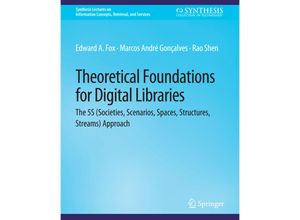In 1991 a group of researchers chose the term digital libraries to describe an emerging field
of research development and practice. Since then Virginia Tech has had funded research in
this area largely through its Digital Library Research Laboratory. This book is the first in a
four book series that reports our key findings and current research investigations. Underlying
this book series are six completed dissertations (Gonçalves Kozievitch Leidig Murthy Shen
Torres) eight dissertations underway and many masters theses. These reflect our experience
with a long string of prototype or production systems developed in the lab such as CITIDEL
CODER CTRnet Ensemble ETANA ETD-db MARIAN and Open Digital Libraries. There are hundreds
of related publications presentations tutorials and reports. We have built upon that work so
this book and the others in the series will address digital library related needs in many
computer science information science and library science (e.g. LIS) courses as well as the
requirements of researchers developers and practitioners. Much of the early work in the
digital library field struck a balance between addressing real-world needs integrating methods
from related areas and advancing an ever-expanding research agenda. Our work has fit in with
these trends but simultaneously has been driven by a desire to provide a firm conceptual and
formal basis for the field.Our aim has been to move from engineering to science. We claim that
our 5S (Societies Scenarios Spaces Structures Streams) framework discussed in publications
dating back to at least 1998 provides a suitable basis. This book introduces 5S and the key
theoretical and formal aspects of the 5S framework. While the 5S framework may be used to
describe many types of information systems and is likely to have even broader utility and
appeal we focus here on digital libraries. Our view of digital libraries is broad so further
generalization should be straightforward. We have connected with related fields including
hypertext hypermedia information storage and retrieval knowledge management machine learning
multimedia personal information management and Web 2.0. Applications have included managing
not only publications but also archaeological information educational resources fish images
scientific datasets and scientific experiments simulations. Table of Contents: Introduction
Exploration Mathematical Preliminaries Minimal Digital Library Archaeological Digital
Libraries 5S Results: Lemmas Proofs and 5SSuite Glossary Bibliography Authors'
Biographies Index

